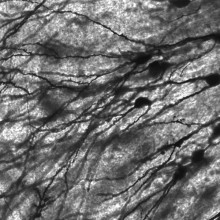Pitting one alien against another may be the way to fight an invasion, especially if the alien is Japanese Knot Weed - we'll find out more in this week's Naked Scientists News Flash! Also, we find out how reading brain activity could mean a new lease of life for paralysed people, why the colour of your childhood TV set may affect your dreams and how a 50 year old experiment has been brought up to date to tell us about the origins of life on Earth.
In this episode

I think therefore I move
Scientists have developed a system that offers patients paralysed by spinal injuries the prospect of regaining the ability to move.
 The breakthrough is the work of Chet Moritz and his colleagues at Washington University in Seattle. Writing in this week's Nature the team describe how they have been able to decode the chatter that goes on between nerve cells in the brain's motor area and then route the signals, via a computer, into muscles directly.
The breakthrough is the work of Chet Moritz and his colleagues at Washington University in Seattle. Writing in this week's Nature the team describe how they have been able to decode the chatter that goes on between nerve cells in the brain's motor area and then route the signals, via a computer, into muscles directly.
The researchers taught monkeys to play a computer video game that involved positioning a cursor on the screen using wrist movements. Local anaesthetic was then used to paralyse the animals' arms whilst an electrode was used to pick up brain cell activity. The activity was fed to a computer which was in turn connected to a muscle stimulator supplying the wrist muscles.
The animals very quickly learned to play the same computer game just by thinking about moving their wrists; the computer picked up on the nerve activity and activated the wrist muscles, enabling the monekys to control the computer.
Interestingly it was clear that the animals' brains were learning to control the computer better as they went along. This suggests that the same trick could work on patients confined to wheelchairs through spinal injury, like the late Christopher Reeve.

Colourful dreaming
Do you dream in black and white or in full glorious technicolour? Your answer could well depend on what sort of TV you watched as a child, because a new study has provided more support for the theory that people who only watched black and white TV and movies as children also dream in black and white instead of colour.
 Studies throughout the 20th century suggested that when colour TV and film arrived, dreams too suddenly shifted from black and white to colour.
Studies throughout the 20th century suggested that when colour TV and film arrived, dreams too suddenly shifted from black and white to colour.
But the age old problem with dream studies is how accurately people report what it was they dreamed. We all know how easy it is to forget about what happened in our dreams.
In earlier studies, from times when TV was still in black and white, researchers asked subjects to complete questionnaires in the middle of the day to record their dreams, so they could have simply been forgetting about their colourful dreams. And then later studies used a different technique of asking people to record their dreams in a diary as soon as they woke up, which should be more accurate.
Now Eva Murzyn from the University of Dundee here in the UK has revisited these earlier studies and repeated the two different methods to verify the link between what we watch and what we dream.
She recruited 60 people to her study, half of them under 25 and half over 55, and gave them a questionnaire to find out what sort of TV they watched as a child and what their dreams were like now. They were also asked to keep dream diaries every morning.
She found was there was in fact no great difference between the two different methods, so the earlier studies probably could well be comparable.
She also found that exposure to black and white TV could still be influencing the dreams of people over 40 years later. In the younger age group less than 5% of people dreamed in black and white and of the older folk who had access to colour TV during their childhood, around 7% dream now in black and white. That's low compared to 25% of the older age group who had not seen a colour TV as a child, and who still dream in black and white.
So, what could be causing these differences in dreaming? There are theories that our dreams are developing up until the age of around 12, which could suggest that exposure to moving images, especially films that we get emotionally involved in, are likely to influence our dreams in a way that stays with us later in life.
This latest study still can't distinguish between two possible explanations for the findings. It could be that exposure to black and white movies as a child really could have a lasting effect on dreams, or it could be instead the widespread cultural beliefs of how we dream that is in fact getting in the way of people correctly remembering their dreams. If you believe that you must be dreaming in black and white, like everyone else apparently is, then that could be enough to convince yourself that you are.
The only way of finding out for sure would be experiments with people who can control their dreams - known as lucid dreaming - can signal while they are dreaming, whether they are seeing in colour or black and white.
But what about people who've never watched TV?

Recreating life on Earth
Scientists have brought a 1950s science experiment back to life, and with it discovered a lot more about how life on Earth got stated in the first place.
 In the 1950s UCSD scientist Stanley Miller made history when he recreated the conditions of the early Earth by mixing some water, methane, hydrogen and ammonia in a glass bottle, boiling the result and zapping it with some synthetic lightning. In the residue remaining he identified 5 types of "amino acid", the building blocks used by life to create proteins. This, he said, strongly argued that "Darwin's warm little pond" from which life sprang 4 billion years ago, was spawned by the early Earth itself.
In the 1950s UCSD scientist Stanley Miller made history when he recreated the conditions of the early Earth by mixing some water, methane, hydrogen and ammonia in a glass bottle, boiling the result and zapping it with some synthetic lightning. In the residue remaining he identified 5 types of "amino acid", the building blocks used by life to create proteins. This, he said, strongly argued that "Darwin's warm little pond" from which life sprang 4 billion years ago, was spawned by the early Earth itself.
Miller died last year but his colleagues, in clearing up his things, discovered notebooks, the original apparatus and the resulting residues that he produced in his experiments fifty years ago.
Now, in a paper in this week's Science, they describe how they re-analysed Miller's material using ultra-sensitive modern chemical analytical techniques. Rather than just 5 of life's building blocks it would appear that Miller had actually made many more. The team, led by UCSD scientist Jeff Bada, document 22 amino acids and at least 5 other amine chemicals in the vestiges of the experiments. This shows, they say, that the conditions on the early Earth could well have produced a host of life-giving chemicals, rather than the handful suggested previously.

Cleaner fish work better in pairs.
Coral reef fishes that spend their lives picking clean other, bigger fish provide a more honest valet service when they work in pairs, showing that it pays off to be cooperate and behave.
 That's according to a study in the journal science this week from a team led by Redouan Bshary from the University of Neuchâte in Switzerland.
That's according to a study in the journal science this week from a team led by Redouan Bshary from the University of Neuchâte in Switzerland.
If you've ever been diving on a coral reef or watched a TV documentary, you might have seen something called a cleaning station, where small, cigar shaped fish called wrasse congregate and dance about advertising their services for hire as cleaners - picking off bits of muck, dead scales and parasites from other fish.
When cleaner fish work in pairs they are posed with a prisoner's dilemma: should they cheat on their client fish and their partners by taking a mouthful of nutritious mucous instead of plucking off a parasite?
It turns out that the cleaner fish much prefer to take a bite of mucous instead of doing their proper cleaning job. But when they do, it's usually their last mouthful because giving their clients a close nip sends them swimming off in a huff. Honest members of a cleaning duo run the risk of loosing out twice over if their cheating partner sends off the client when they themselves haven't gained from a morsel of mucous.
This new study suggests that as long as the fish being cleaned decides when it's time to leave, cleaner fish working in pairs are much less likely to cheat than when they work solo.
What Bshary and his team built a game-theory model to predict the outcome of the cleaner fishes' prisoner's dilemma which showed that the cleaner partnership gets more food when they are both honest compared to when one of them cheats. And the fish visiting the cleaning station also benefit from a better overall service and fewer nasty nips.
The researchers also went out and watched cleaning stations on coral reefs, and saw that when cleaners operated in pairs, the client fish jolted less - that is a response to being nipped, compared to when either female or male fish worked alone. And the difference seems to come down to the females, rather than the males changing their behaviour.
In the laboratory too, the cleaner fish showed their willingness to do the decent thing and not cheat - when offered a choice of food, the paired fish would eat more of their non-preferred food compared to when they were on their own.
All in all, this gives us a better understanding of how the remarkable cleaner-client relationships have evolved and why everyone involved doesn't cheat all the time. And similar things may well be going in other pairs of species that get along and do eat other favours, like the nitrogen fixing bacteria that live inside the roots of leguminous plants, and the butterfly larvae that produce sugars to feed ants that then defend the butterflies from predators.
And it just goes to show that there certainly are weird and wonderful things that go on in the natural world.

12:12 - Japanese Knotweed - An alien to fight an alien?
Japanese Knotweed - An alien to fight an alien?
John Bailey, University of Leicester
Chris - Someone who's worked on knotweed for a very long time, that's John Bailey from the University of Leicester. Hello, John.
John - Good evening.
 Chris - Welcome to the naked Scientists. Just tell us a little bit about knotweed. What is it?
Chris - Welcome to the naked Scientists. Just tell us a little bit about knotweed. What is it?
John - Basically, it's in the polygonum family which we know mostly as dock and things like that. It's part of a giant herb community. It's herbaceous although it grows to 2 or 3 metres per year it dies down and the resources are preserved in a woody risome.
Chris - Why's it such a pest?
John - There's nothing magic about it. If you found a rosette that had just started to grow and weedkilled it, it would kill it stone dead. The problem is that in established colonies there are enormous amounts of biomass stored under the soil going down some metres.
Chris - Metres underground it's actually got rootstock from which it can regenerate a plant?
John - Technically, they're risomes - woody stems. I've got some pieces of wood from these things and you could give someone a nasty injury with them.
Chris - So they're pretty robust. What are scientists suggesting this week that we do in order to weed out the problem?
John - Basically one of the reasons it's so successful over here is it's left all its predators behind. In Japan you rarely see an undamaged plant. The idea is that by producing a slightly more level playing field you've tipped the advantage in favour of people who are actually trying to control the plant.
Chris - What pests are the scientists suggesting that we bring into the UK in order to get rid of this plant?
John - A small bug Aphalara itadori and it's a leaf-sucker. In laboratory tests it's proved very encouraging.
Chris - How do you test out whether or not something's going to have knock-on effects? It might just start attacking the knotweed but then it might develop a taste for other native species. As it's another invasive animal it might then cause more of a problem.
John - Quite right. The testing is comprehensive as possible. It's what's called the centrifugal method of testing. First of all you look at species related to the target plants: particularly crop plants such as rhubarb, buckwheat and endangered species. I think we have a species of shore dock that's endangered. Secondly you look at hosts of plant species closely related to the candidate organism then unrelated plants with morphological or biological characteristics in common with the target. Although some insects are very good taxonomists others will go for particular biochemical parts of the plants. Finally a range of crop plants: particularly those that have never been exposed to the candidate agent before.
Chris - There's not really any substitute for the real world. There's always the danger that you might have missed something, isn't there?
John - Absolutely. You can't cover absolutely every eventuality. You can only get 99% assurance.
Chris - Finally, how do you think this will actually solve the problem?
John - It won't be a magic bullet. The people promoting it don't believe that either. You've still got to carry on educating people about not spreading these plants. You've also got to carry on with the conventional control measures.
Chris - And of course not introduce them in the first place. Thank you Dr John Bailey.
Related Content
- Previous Mind control, TB...
- Next Better Battery Life










Comments
Add a comment